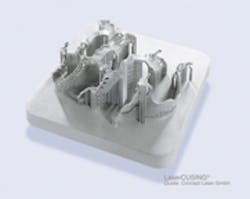Spectrum of materials for generative dental prosthetics expanded
Lichtenfels, Germany - Concept Laser, manufacturer of LaserCUSING systems, and Dentaurum, Ispringen, Germany, powder manufacturer, have completed the certification process for the rematitan CL titanium alloy so that it is now available as an implantable material for use with Concept's generative laser melting process. The Dentaurum Group and Concept Laser began exclusive cooperation in laser fusing of dental alloys in 2010.
The Grade 5 titanium alloy has been used in dental prosthetics and implantology for many years and supplements the available spectrum of cobalt-chromium alloys. It is intended for restorations requiring a combination of high rigidity and firmness, e.g., thin, removable partial prosthetics and parts with thin cross-sections or braces. The products produced using this process comply with the requirements pursuant to the German Medical Products Act and the relevant standards.
Changes in dentistry
Dental technology is currently undergoing radical change. These changes are affecting products, customer requirements, and business processes. Digital process networking is linking dentists, laboratories, and dental manufacturing more closely than ever and putting everyone involved under pressure to act. The entire process chain, from impression-making to prosthetic restoration, is undergoing a dynamic transition, a trend away from casting and toward digital, additive manufacturing.
For example, Dentaurum www.dentaurum-implants.de manufactures the pulverized alloy for use in the laser melting (additive manufacturing) process. The very fine-grained microstructure of the laser-molten parts of this titanium alloy allows greater firmness than with conventional castings. The generative structure also allows for secure, durable veneers. Surface defects associated with casting, such as shrink holes, are no longer a problem with the laser melting process. Moreover, the technique opens up new possibilities for dental technicians and dentists in terms of accuracy, geometrical freedom, and finer braces. Both users and patients benefit from the quick turnaround of the process. Prosthetic restorations are essentially ready "overnight."
The laser melting process
The LaserCUSING process makes it possible to economically produce crown copings, bridges, cast parts, as well as primary and secondary structures from rematitan CL. In addition to mechanical equipment, the alloy powder is essential for a high-quality prosthetic framework: The composition, powder form, grain size, and grain size distribution determine the quality and precision of the parts produced.
With LaserCUSING, finely pulverized metal is fused locally using a laser . After cooling, the material solidifies. The component's contour is achieved by directing the laser beam with a mirror deflection unit (scanner). Construction takes place layer by layer (with each layer measuring 20 to 50 microns) by lowering the bottom surface of the construction space, then applying and fusing more powder. Economic consumption of materials is one advantage of the process, since it works according to additive principles. Only the amount of powder required for production is fused.
Concept Laser GmbH is an independent company of the Hofmann Innovation Group. Since its founding in 2000, it has been a leading innovator in the field of laser melting with the patented LaserCUSING technology across many industries.
----
Photos:
(top): Generative cast part prosthesis: Fine geometrical shapes on a construction space plate as an unmachined part produced using the LaserCUSING process.
(bottom): Laser melting allows for better optics thanks to finer structures as shown in thinner braces on cast part prostheses.
